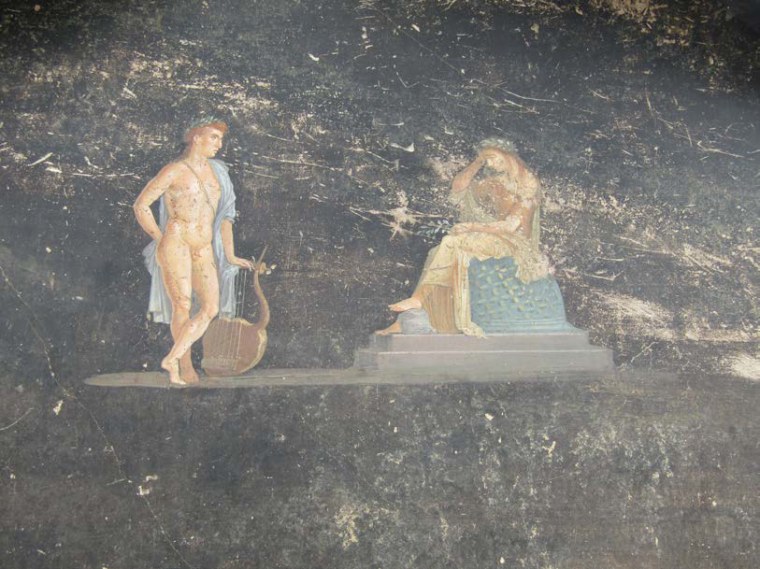begin quote from:
https://www.nbcnews.com/news/world/roman-paintings-uncovered-pompeii-2000-years-rcna147350
Striking Roman paintings uncovered in Pompeii after nearly 2,000 years
Buried and unseen for nearly 2,000 years, a series of striking paintings showing Helen of Troy and other Greek heroes has been uncovered in the ruined Roman town of Pompeii.
Discovered inside what archaeologists described as a “spectacular dining room” with unusual black walls, the remarkably well-preserved frescoes were inspired by the Trojan War, as recounted by the Greek poet Homer.

The startling finding — one of the most important in years — was revealed to the public on Thursday. It comes from block No. 10 of Pompeii’s ninth section, a never-before excavated area of the town destroyed in the eruption of the Vesuvius volcano in 79 A.D.
For wealthy politicians and business owners, an elaborate classical painting, complete with animals, was a prime showpiece and talking point when entertaining guests.
“It provided a refined setting for entertainment during convivial moments, whether banquets or conversations, with the clear aim of pursuing an elegant lifestyle,” the Archaeological Park of Pompeii said in a news release.
Pompeii and nearby Herculaneum were seaside resorts favored by wealthy Romans when they were devastated by the eruption, which lasted for more than 24 hours and had the power of many thousands of nuclear bombs.
The room is 50 feet long and 20 feet wide and opens onto a courtyard with a staircase leading to the first floor. The frescoes are in such good condition that some have speculated they may have been painted just before Vesuvius erupted.

Apparently abandoned tools and building materials, and some less impressive artwork, add weight to this theory. In the fresh plaster of an adjoining stairway’s arches, experts identified a charcoal drawing of two pairs of gladiators. Nearby is “what appears to be an enormous stylized phallus,” meaning penis.
A hint to the identity of the villa’s owner was given by the discovery of the initials ARV on a wall — experts believe this to be Aulus Rustius Verus, a rich politician mentioned in political propaganda of the period.
High Roman society was steeped in Greek mythology. The wealthy citizens who owned houses in Pompeii and Herculaneum would have known well the stories of Helen of Troy, Paris, Cassandra and Apollo, the Roman god of arts — all of whom are depicted in the frescoes.
“The dominant theme seems to be that of heroism, shown by the depictions of pairs of heroes and deities involved in the Trojan War, but also of fate and, at the same time, of the possibility, often not seized, that humans have of changing their own destiny,” the park’s news release said.
“These stories were very much part of their foundation because the Romans actually believed that their whole people had descended from the people who were at Troy,” Daisy Dunn, an award-winning author and classicist, added.

Gabriel Zuchtriegel, director of the archaeological park, said in a statement that the black walls and the flickering light of oil lamps would create the illusion of the paintings moving, “especially after a few glasses of good Campanian wine.”
Zuchtriegel also argued that the black color scheme helped to hide the smoke from the lamps.
But Dunn argued that this was more likely an aesthetic choice.
“You’re walking into a room with an all-white floor, all-black walls. I mean, that’s something that would be impressive today and it definitely was back then,” she said.
The discovery underlines just how much of Pompeii remains buried: More than a third of Pompeii is untouched and unexplored by archaeologists.
The excavation revealed this week is part of a much larger project to help protect and preserve the excavated and unexcavated areas of Pompeii, which already include more than 13,000 rooms in 1,070 houses and apartments.
“One of the most extraordinary things visitors don’t always realize is that up to a third of the city is still unexcavated. There’s been more of a focus in recent years on preservation and safeguarding what’s already been found than on finding new stuff,” Dunn said.



No comments:
Post a Comment